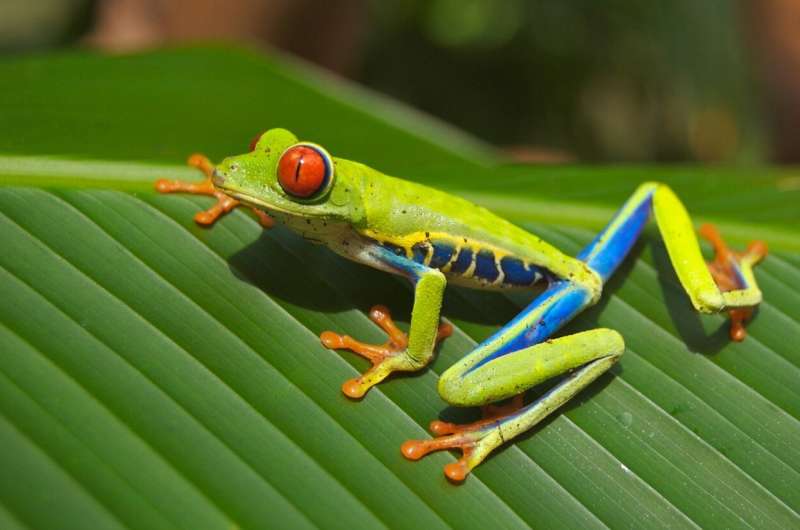New gene-editing kit puts the power of frog growth into citizen scientists' hands

In an ordinary house tucked away on a quiet street in Oakland, Josiah Zayner stands over a container filled with green tree frogs with a syringe in hand.
He carefully injects a liquid into a frog's back while a cage full of crickets chirp in the background. In four to five weeks, this tiny tree frog will almost double in size.
"I want to take the knowledge I have and translate it so I can blow peoples' minds," said Zayner, whose ears glitter with an assortment of silver earrings.
Since founding his company, The Odin, in 2006, Zayner and his team have been striving to give the public the education and tools to safely edit organisms' genes. So far, they have sold thousands of gene-editing kits and brought in around $500,000 in revenue just last year. With these inexpensive devices, individuals can practice feats of science once contained to a lab, such as making glow-in-the-dark yeast and precise gene mutations in bacteria.
Now, with the release of the new frog kits last November, people can alter a frog's anatomy with a few simple injections right in their own home.
"When we watch movies and when we dream, the stuff we want is humans with wings or dragons," said Zayner. "People are more interested in the creative, arty side of science. And you can't get grants for that stuff."
Zayner is no stranger to the world of gene-editing.
After receiving his Ph.D. in molecular biophysics from the University of Chicago, he worked for the NASA Ames Space Synthetic Biology program for two years where he engineered bacteria that could help transform Mars into a planet suitable for human life.
Since 2016, he has invested his time fully in The Odin and became known for his controversial do-it-yourself CRISPR kits.
But unlike the CRISPR kits, the frog kit employs a lesser known gene-editing process called formulated liquid to enhance the engineering of biology, or FLEEB.
FLEEB uses a special liquid that is a mixture of fats and a protein called insulin-like growth factor, or IGF-1, that is critical in tissue and muscle growth in adults. Once injected into the frog, the fats allow for IGF-1 to slip smoothly through the cell wall. The DNA within IGF-1 then tricks the cell into thinking it is part of the cell's DNA, thus stimulating cell growth.
But these changes are not carried onto the frog's offspring. The cells modified by IGF-1 injections are not the same as the frog's reproductive cells that make up their sperm or eggs.
Zayner's goal is to promote this type of science in high school classrooms around the globe.
"We're trying to say, 'Look, your high school doesn't need to do frog dissection anymore,'" he said. By giving students the opportunity to do hands-on gene editing projects, "they can move into 2019 and do modern scientific experiments."
Biochemist Kate Adamala, who is a guest lecturer on Zayner's online CRISPR and biohacking class, believes these classes are key in dispelling public fears and misunderstandings around genetic engineering. They may also promote more students to pursue a career in science.
"If we expose more people to the idea that it's not black magic, they may consider going into science," said Adamala. "It can make science education more fun and show people who thought they were not smart enough to go into science that they really are."
But Stanford University infectious disease expert Dr. David Relman, who co-directs the Center for International Security and Cooperation, has serious concerns.
Although Relman supports the thoughtful and productive engagement in science by the general public, he strongly opposes Zayner's method.
"You can't simply go into a cockpit and fly a plane," said Relman. "Likewise, you can't simply pick up a pipette and do science."
Science involves a set of moral and ethical principles, particularly when it comes to animal testing. Handing out frog gene therapy kits for anyone to use is a clear noncompliance with those principles, argues Relman.
"There is a sense from looking at this work that frogs have been judged to be of lesser meaningfulness and value, and therefore it is OK to play with their genomes," he said. "I reject that."
Although the gene-editing only modifies the frog's non-reproductive cells, Relman worries that these kits are the beginning of a slippery slope.
Zayner assures that the creation of his frog gene therapy kits involved extensive research and compliance with animal testing laws. However, he understands that selling these kits will stir up a lot of anger and apprehension.
"What I'm learning is that the timing (in selling the kits) is sometimes more important than just knowing you can do it," he said.
But regardless of other's reactions, Zayner is determined to continue breaking new grounds in the field of gene-editing, particularly through his online CRISPR tutorial—one of The Odin's most popular items.
By reaching as wide of an audience as possible, he hopes citizen scientists will eventually use their education to uncover new opportunities in gene-editing and invent products that can one day save lives.
"When science and gene-editing enter our culture through people exploring the unknown, I think that's when I will feel happy," Zayner said. "I want to live in that world."
©2019 The Mercury News (San Jose, Calif.)
Distributed by Tribune Content Agency, LLC.



















